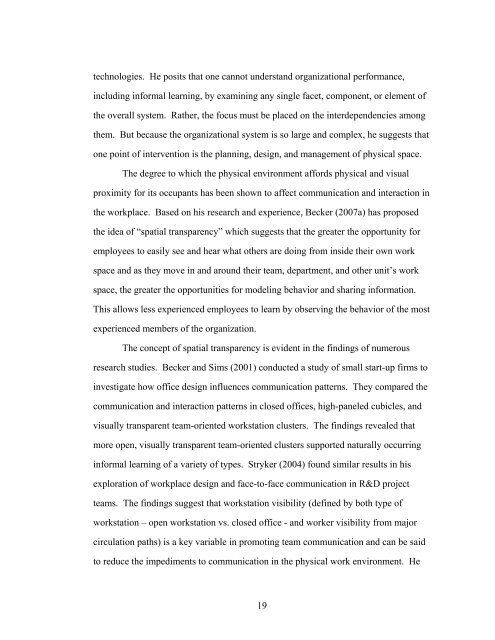The role of physical design and informal communication
The role of physical design and informal communication
The role of physical design and informal communication
You also want an ePaper? Increase the reach of your titles
YUMPU automatically turns print PDFs into web optimized ePapers that Google loves.
technologies. He posits that one cannot underst<strong>and</strong> organizational performance,<br />
including <strong>informal</strong> learning, by examining any single facet, component, or element <strong>of</strong><br />
the overall system. Rather, the focus must be placed on the interdependencies among<br />
them. But because the organizational system is so large <strong>and</strong> complex, he suggests that<br />
one point <strong>of</strong> intervention is the planning, <strong>design</strong>, <strong>and</strong> management <strong>of</strong> <strong>physical</strong> space.<br />
<strong>The</strong> degree to which the <strong>physical</strong> environment affords <strong>physical</strong> <strong>and</strong> visual<br />
proximity for its occupants has been shown to affect <strong>communication</strong> <strong>and</strong> interaction in<br />
the workplace. Based on his research <strong>and</strong> experience, Becker (2007a) has proposed<br />
the idea <strong>of</strong> “spatial transparency” which suggests that the greater the opportunity for<br />
employees to easily see <strong>and</strong> hear what others are doing from inside their own work<br />
space <strong>and</strong> as they move in <strong>and</strong> around their team, department, <strong>and</strong> other unit’s work<br />
space, the greater the opportunities for modeling behavior <strong>and</strong> sharing information.<br />
This allows less experienced employees to learn by observing the behavior <strong>of</strong> the most<br />
experienced members <strong>of</strong> the organization.<br />
<strong>The</strong> concept <strong>of</strong> spatial transparency is evident in the findings <strong>of</strong> numerous<br />
research studies. Becker <strong>and</strong> Sims (2001) conducted a study <strong>of</strong> small start-up firms to<br />
investigate how <strong>of</strong>fice <strong>design</strong> influences <strong>communication</strong> patterns. <strong>The</strong>y compared the<br />
<strong>communication</strong> <strong>and</strong> interaction patterns in closed <strong>of</strong>fices, high-paneled cubicles, <strong>and</strong><br />
visually transparent team-oriented workstation clusters. <strong>The</strong> findings revealed that<br />
more open, visually transparent team-oriented clusters supported naturally occurring<br />
<strong>informal</strong> learning <strong>of</strong> a variety <strong>of</strong> types. Stryker (2004) found similar results in his<br />
exploration <strong>of</strong> workplace <strong>design</strong> <strong>and</strong> face-to-face <strong>communication</strong> in R&D project<br />
teams. <strong>The</strong> findings suggest that workstation visibility (defined by both type <strong>of</strong><br />
workstation – open workstation vs. closed <strong>of</strong>fice - <strong>and</strong> worker visibility from major<br />
circulation paths) is a key variable in promoting team <strong>communication</strong> <strong>and</strong> can be said<br />
to reduce the impediments to <strong>communication</strong> in the <strong>physical</strong> work environment. He<br />
19







